
Haworth is a village in the City of Bradford in West Yorkshire, England, in the Pennines, 3 miles (5 km) south-west of Keighley, 10 miles (16 km) west of Bradford and 10 miles (16 km) east of Colne in Lancashire. The surrounding areas include Oakworth and Oxenhope. Nearby villages include Cross Roads, Stanbury and Lumbfoot.

Keighley is a market town and a civil parish in the City of Bradford Borough of West Yorkshire, England. It is the second largest settlement in the borough, after Bradford.
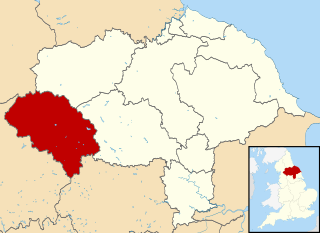
Craven was a non-metropolitan district in the west of North Yorkshire, centred on the market town of Skipton.

Cross Hills is a village in the Craven district of North Yorkshire, England that is situated halfway between Skipton and Keighley. The village is at the centre of a built-up area that includes the adjoining settlements of Glusburn, Kildwick, Eastburn and Sutton-in-Craven. Cross Hills is the newer part of the civil parish now called Glusburn and Cross Hills, historically known as Glusburn.

Barnoldswick is a market town and civil parish in the Borough of Pendle, in the administrative county of Lancashire, England. It is within the boundaries of the historic West Riding of Yorkshire. Barnoldswick and the surrounding areas of West Craven have been administered since 1974 as part of the modern administrative county of Lancashire. This was when West Riding County Council and Barnoldswick Urban District Council were abolished and the town was transferred to the Borough of Pendle.

Oakworth Hall is located in Oakworth, West Yorkshire, England. The manor house was rebuilt in the 17th century, but has a history dating back to 1066. The building overlooks the Worth Valley, facing south towards Haworth.
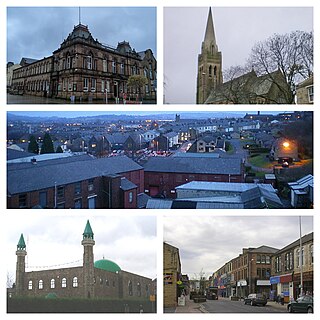
Nelson is a town and civil parish in the Borough of Pendle in Lancashire, England, with a population of 29,135 in 2011. It is 4 miles (6.4 km) north of Burnley and 3 miles south-west of Colne.
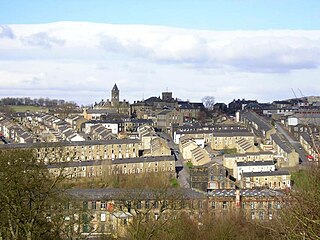
Colne is a market town and civil parish in the Borough of Pendle in Lancashire, England. Located three miles northeast of Nelson, six miles northeast of Burnley, 25 mi (40 km) east of Preston and 30 mi (50 km) west of Leeds.
Kildwick, or Kildwick-in-Craven, is a village and civil parish of the district of Craven in North Yorkshire, England. It is situated between Skipton and Keighley and had a population of 191 in 2001, rising slightly to 194 at the 2011 census. Kildwick is a landmark as where the major road from Keighley to Skipton crosses the River Aire. The village's amenities include a primary school, church and public house.

Barrowford is a large village and civil parish in the Pendle district of Lancashire, England. It is situated to the north of Nelson on the other side of the M65 motorway, and forms part of the Nelson conurbation. It also comprises the area of Lowerford. The parish has a population of 6,171. The community is located near the Forest of Bowland, an Area of Outstanding Natural Beauty while the Borough of Pendle is at the southern edge of the Yorkshire Dales.

Sutton-in-Craven is a village, electoral ward and a civil parish in the Craven district of North Yorkshire, England that is situated in the Aire Valley between Skipton and Keighley. Historically part of the West Riding of Yorkshire, in 2001 the population was 3,480, increasing to 3,714 at the Census 2011. The village is adjacent to Glusburn and Cross Hills, but although these three effectively form a small town, Sutton village maintains its distinct identity.

Cowling is a village, electoral division and civil parish in the Craven district of North Yorkshire, England. It is situated on the borders with the adjacent counties of West Yorkshire, and Lancashire.

Kildwick and Crosshills [sic] was a railway station off Station Road in Cross Hills, North Yorkshire, England. It served the villages of Cross Hills, Cowling, Glusburn, Kildwick and Sutton-in-Craven.
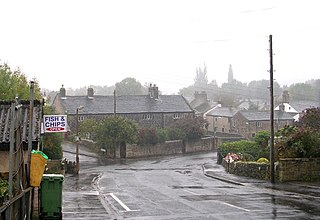
Utley is a village that forms a suburb of the town of Keighley within the county of West Yorkshire, England, approximately 1.5 miles (2.4 km) from the town centre.

St Michael and All Angels' Church is the Church of England parish church of Haworth, West Yorkshire. The current structure, the third church building on the site, was built between 1879 and 1881 although parts of the original medieval church building, notably the tower, survive from earlier periods.

Steeton is a village in the City of Bradford metropolitan borough, West Yorkshire, England. Historically part of the West Riding of Yorkshire, it is situated approximately 5 miles (8 km) south-east from Skipton, 3 miles (5 km) north-west from Keighley and just south of the A629 road. The village is part of Steeton with Eastburn civil parish.

The Keighley and Kendal Turnpike was a road built in 1753 by a turnpike trust between Keighley in the West Riding of Yorkshire and Kendal in Westmorland, England. The primary instigators were in Settle. The road followed a modified ancient route through Craven. It necessitated bridge widening, reorientation in some of the towns it passed and the relocation of inns and stables. The road was of great benefit to commerce in the northwest but proved a financial loss as the cost of repairing wear caused by heavy traffic was underestimated. The trust's records were lost when it closed.
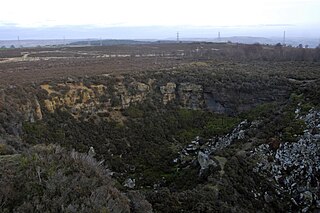
Harden Moor is an expanse of moorland that lies north of the village of Harden in West Yorkshire, England. The moor encompasses stretches of heather, woodland and former quarry workings and is bordered by Airedale to the east, the Worth Valley to the north and Catstones Moor and the village of Cullingworth to the west. Historically, Harden Moor occupied the high ground between Bingley, Keighley, Cullingworth and Harden. Altar Lane, an unmade road which runs from the Brown Cow Inn in Bingley to Keighley Road on Harden Moor is an unofficial border between the estate of St Ives and Harden Moor, but when the St Ives Estate was created, a large swathe of Harden Moor was taken over.

The Worth Valley is a geographic area in West Yorkshire, England, that extends eastwards from Crow Hill and Oxenhope Moor, providing drainage for the River Worth for nearly 10 miles (16 km) to the River Aire. It is a side valley to Airedale, with the River Worth being a major tributary of the River Aire. The Worth Valley was important for its contribution to the textiles industry of the West Riding of Yorkshire and was furnished with several reservoirs to allow mills to operate within the valley. Most of the reservoirs are still in use into the modern day.



















